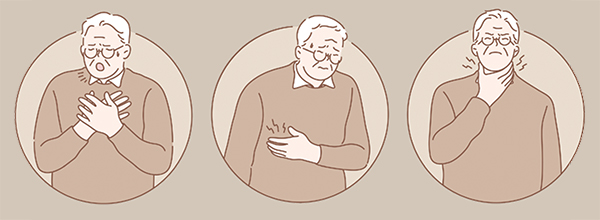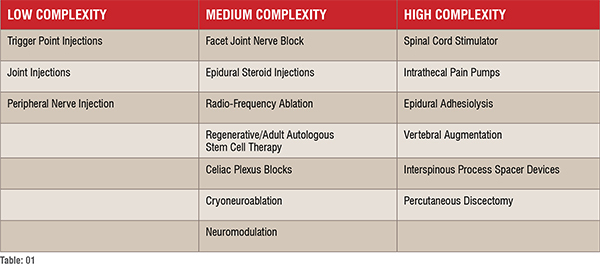Pain medicines and pain management are some of the emerging specialities in several Indian hospitals aiming to revitalise and improve the quality of patient’s life by relieving the pain and minimising the sufferings. For various types of pains ranging from acute pains to chronic ones, including neuropathic, nociceptive, and radicular pains, pain management practices are very crucial and mandatory as many a times ignorance, under-reporting and mismanagement can lead to undesired, unbearable circumstances in patient’s life.

Pain is a sensation which we all experience at various stages of our lives to a greater or lesser extent. Pain perception varies from individual to individual. Sometimes, we don’t require any medical support in order to get rid of this sensation and sometimes, when it’s unbearable and uncontrollable, medical interventions are mandatory. Such interventions are composed of wide range of techniques, skills and medications in hospitals. And these collaborative efforts are often termed as ‘pain management’, which is a most significant part of medicine.
Unlike developed countries, pain management is still an emerging field in India. Many developed countries have specialised, well-structured pain management programmes in their hospitals. Several countries have already adopted the drug-free pain management approaches in order to minimise the risk associated with the opioid medications. Pain management drugs can’t be excluded from the regimen but can be partly replaced with such drug-free approaches.
Due to increasing drug-free approaches, the pain management devices market is expected to account for US$5.97 billion by 2026, growing at CAGR of 8.5 per cent from US$3.97 billion in 2021. Rising surgical procedures in recent healthcare scenario followed by invention of new pain relief devices could be some growth boosting factors for this market. Moreover, increasing geriatric population and chronic diseases like osteoarthritis, cancer, diabetes, etc are also fuelling the growth rate of pain management devices and drugs market.
Following are some promising trends which can be seen in pain management in hospitals in the recent times and the years ahead:
1. Non-addictive substitutes to narcotic painkillers
Electrical stimulation devices are commonly used devices to reduce pain nowadays. As it’s a safe substitute to narcotic addictive drugs, it can be frequently seen in hospital’s pain management procedures.
Low frequency impulses provided by this device predominantly reduces the activity of sympathetic nervous system and decline pain in patients and improve blood and oxygen flow.
2. Pain moderniser
Often called as spinal cord stimulator, is a device implanted below the skin which generates small electrical impulses around the spine base. As the pain moderniser used nowadays can be automated, patient can regulate the intensity of impulses based on the intensity of pain they are experiencing.
Pain moderniser are still under investigation in order to establish a better and secure device which can target specific types of pains in the patient.
3. Stem cell technique
It is one of the techniques in pain management in hospitals which can gain immense demand in coming years. This technique involves abstraction of our own cells and re-injecting them into our injured or painful area. These stem cells and platelet-rich plasma help in healing wounds and reducing the sensation of pain.
4. CAM
Owing to the risks and adverse events associated with the conventional medications, use of CAM (Complementary and alternative medicines) is on the rise in today’s scenario. The therapies consisting of various types of massages, acupuncture, tai chi, etc., which are the part of CAM are rooting to the greater extent in healthcare owing to their holistic approach toward overall wellbeing.
Moreover, escalating use of herbal and dietary supplements accompanied with classic nutraceuticals is also one of the promising trends for overall healthcare.
Such promising trend can shape the pain management programmes of hospitals in much constructive and fruitful manner.
Now look at how hospitals manage pain
Pain management could be simple or complex, depending upon the type of pain and causes behind it. Ranging from acute pains to chronic pains, the way of managing each type is different. Acute pains, often cause due to clearly defined causes like injury, are managed by healing its underlying issues. Whereas, chronic pains, associated with arthritis like health conditions, require different ways of handling.
Mentioned ahead are the four broad treatment categories usually used in the hospitals-(Fig-01)

1. Medications
Depending upon the type of pain, mechanism associated with it and the risk associated, various classes of medications which are consisting of opioids and non-opioids are used in pain management in hospitals. Proper risk- benefit assessment through history, physical examination and appropriate diagnostic procedure is ensured before initiating the particular medication.
Owing to the risks associated with opioids drugs, hospitals are now enhancing the use of non-opioids like NSAIDS, acetaminophen, antidepressants, anticonvulsant and many other drugs which can mitigate and minimise opioid exposure. Clinicians have to be very careful about the patient's medical history and also have to discuss the medications thoroughly with patients to avoid any complications associated with the lack of safety information about the drugs.
In case, any emergency like opioid overdose happens with any patient, hospital always have enough availability of opioid antagonist like Naloxone and other medications used to minimise the risk of overdose.
2. Restorative therapies
Drug treatment is often followed by restorative therapies which are implemented by the physiotherapist or occupational therapist in the hospital.
Like mentioned earlier, several types of pain management devices are used in hospitals. Transcutaneous electric nerve stimulation is one of the methods used in hospitals in which low voltage electric current is used to minimise the pain. In addition to this, various massage techniques like Swedish massage (deep circular moments, long strokes, kneading) and shiatsu (applying pressure with thumb and fingers) and deep tissue massage focusing on deeper layers of tissues are employed.
Cold and heat treatment, therapeutic ultrasounds and therapeutic exercises are also used in number of hospitals. Pain management speciality hospitals are equipped with more such therapies and techniques in to manage pain efficiently.
3. Interventional procedures
These are the diagnostic and treatment procedures used in hospitals for pain management. These procedures are very important in order to decide right steps before initiating opioid medications and extensive surgeries.
Depending upon the degree of complexity, following are the interventional techniques used in hospitals: (Table:01)

Provided that the safety and efficacy of these therapies are extensively studied and implemented, these techniques are the attractive alternatives for lengthy opioid therapy.
4. Behavioural health approaches
Behavioural, emotional and many other psychological aspects of pain can influence the results of treatment patient undergoing. To manage these aspects, certain hospitals provide behavioural therapies, mindfulness
and stress reduction therapy, emotional awareness and expression therapy and many more. Such approaches are very useful while dealing with the patients to overcome the pain more efficiently.
Many health systems consider the CAM system for holistic recovery of the patients. Also, hospitals which have highly specialised system for pain management even classify the services according to the specific population (eg., Child, adults, women, pregnant women, elderly, etc.) and specific health conditions like blood diseases.
Many hospitals in abroad employ best practices in risk assessment and educational programs for public and patients.

Way forward
Owing to the history of opioid use disorder, hospitals face significant challenges in pain management. To improve patient care, extensive research can be employed in the possible areas of managing pain.
Educational programmes should be launched in every hospital for physicians, nurses and hospital staff to deal effectively with the patient in their pre- and post-operative traumatic condition. Moreover, many times, lack of knowledge about opioids addiction, dependence and withdrawal leads to emergency situation which require special attention. To handle such situations and to educate patients about using opioids, educational programmes are necessary.
In addition to this, patient’s rehabilitation therapies play crucial role in the recovery process of the patient. In today’s scenario, where digitalisation of healthcare is on the rise, virtual rehabilitation can be a better option and much convenient as well. Virtual therapies consisting of Yoga, different types of exercises can boost the recovery and also minimise the healthcare expenditure.
In this digital world, where healthcare is evolving like never before, pain management in hospital also require more attention looking at ever-growing surgical procedures and lifestyle diseases.